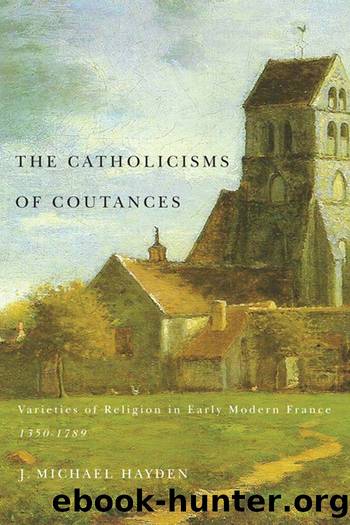The Catholicisms of Coutances by Hayden J. Michael;

Author:Hayden, J. Michael;
Language: eng
Format: epub
Publisher: McGill-Queen's University Press
7
The Catholicisms of the Catholic Laity of Coutances
Chapter 2 contained a description of the official Catholicism of Coutances in the years between the mid-fourteenth century and the end of the Council of Trent, as well as an overview of the unofficial Catholicism of those years. Chapters 3 through 6 presented the catholicisms of the clergy and religious of the diocese. In passing, the different ways in which the clergy tried to teach official Catholicism to the laity at different times were mentioned â from medieval instruction in a few basics to the sermons and catechism lessons of the seventeenth and eighteenth centuries.
The purpose of this chapter is to describe the catholicisms of the Roman Catholic laity of the Diocese of Coutances from the mid-sixteenth century to the French Revolution. The journals of Gilles de Gouberville provide important but partial information for the second half of the sixteenth century. The hunt for the catholicisms of the laity is much easier in the seventeenth and eighteenth centuries because of the writings of rural missionaries, pastoral visit records, and the cahiers prepared for the Estates General of 1614 and 1789.
Since it took four chapters to describe the catholicisms of the members of the First Estate of the diocese, who made up no more than 1 per cent of the population, how is it possible to treat the other 99 per cent in only one chapter? It can be done because, for much of the time under consideration, the 99 per cent had what could be called a single general catholicism composed of slightly varying blends of beliefs and practices that had their roots in centuries of Catholic teaching and the supposedly no longer extant Roman and northern European varieties of paganism. The proportion of the blend of official and unofficial beliefs varied individually and collectively. It was influenced by many factors, but the elements were the same, and the overall differences were not great in 1350, 1450, or even 1550. Then, in the course of the seventeenth and eighteenth centuries, the catholicism of the laity began to develop into the catholicisms of the laity.
A myriad of historical studies have documented the changes that came to French society from the sixteenth century onward. Particularly important in the Diocese of Coutances were the spread of literacy, the development of agrarian capitalism, and the growth of royal power. All these contributed to the decline of the seigneurial system, the rise of village ruling groups composed of farmers and rural merchants, and the growing social and political importance of royal officials.
As a result of these developments and others, especially the Renaissance and the nascent Protestant Reformation, by the mid-sixteenth century several vectors of belief were becoming evident in the diocese. With the development of different levels of general and religious education, these vectors would slowly but steadily evolve in different directions. This process became more evident by the late seventeenth century as the influence of the Catholic Reformation, the Scientific Revolution, and the Enlightenment expanded.1
Nevertheless, at the
Download
This site does not store any files on its server. We only index and link to content provided by other sites. Please contact the content providers to delete copyright contents if any and email us, we'll remove relevant links or contents immediately.
| Antitrust | Civil Law |
| Emigration & Immigration | Federal Jurisdiction |
| Housing & Urban Development | Indigenous Peoples |
| Land Use | Public |
| Public Contract | Public Utilities |
| Urban, State & Local Government |
Killers of the Flower Moon by David Grann(3272)
Machine Learning at Scale with H2O by Gregory Keys | David Whiting(2338)
Will by Will Smith(2087)
Guns, Germs and Steel by Diamond Jared(1896)
Borders by unknow(1795)
The Room Where It Happened by John Bolton;(1726)
The Color of Law by Richard Rothstein(1581)
Once Upon a Broken Heart by Stephanie Garber(1536)
Water Rights and the Environment in the United States by John Burch(1418)
Friends, Lovers, and the Big Terrible Thing by Matthew Perry(1360)
Examples & Explanations: Administrative Law by William F. Funk & Richard H. Seamon(1336)
A Short History of War by Jeremy Black(1314)
The Strength In Our Scars by Bianca Sparacino(1299)
HBR's 10 Must Reads 2022 by Harvard Business Review(1268)
Pharmacy Practice and The Law by Richard Abood(1260)
That Every Man Be Armed by Stephen P. Halbrook(1246)
The Guarded Gate by Daniel Okrent(1229)
515945210 by Unknown(1221)
Injustices by Ian Millhiser(1206)
